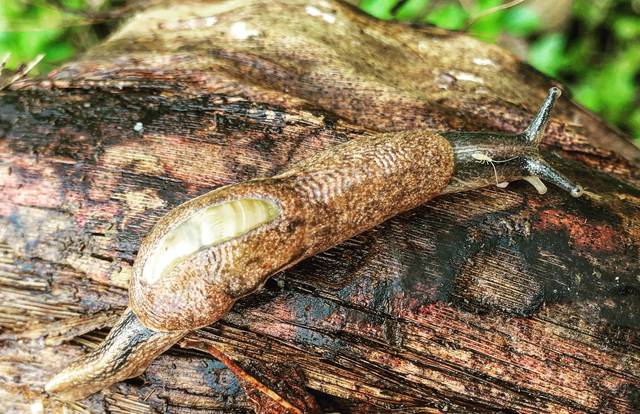2 new cases of rat lungworm contracted on Big Isle confirmed

Photo courtesy of M. Medeiros Snails, rats and semi-slugs, such as this one, can transmit the rat lungworm parasite.
The state Department of Health confirmed two new cases of rat lungworm disease, both of which were contracted on the Big Island.
The state Department of Health confirmed two new cases of rat lungworm disease, both of which were contracted on the Big Island.
An adult visitor who vacationed in North Hawaii last year became ill in late December, but was not diagnosed until they were hospitalized for their symptoms after returning to the mainland, according to a DOH news release. The individual was hospitalized for a short time and has since recovered.
ADVERTISING
The visitor was the seventh person from Hawaii Island, and ninth in the state, to test positive for the disease in 2018, the DOH said.
A second case was identified in an adult resident of East Hawaii, who became ill in January and was hospitalized in early February for treatment, the DOH said. It is the first case of rat lungworm disease confirmed in Hawaii this year.
Investigations are still ongoing to learn more about the most recent patients, but it is currently unknown how or where the individuals became infected.
“Our investigators are working diligently to communicate with the patients and learn more about how they may have become infected with rat lungworm disease,” said Health Director Bruce Anderson. “Determining the exact source of infection in any individual is challenging since it requires a deep dive into a person’s food consumption history as well as where they may live, work, travel and recreate. We know that most people get sick by accidentally eating infected slugs and snails. Taking precautions — such as washing all fresh produce before enjoying and getting rid of slugs and snails around our homes and communities — can go a long way toward preventing infection.”
Rat lungworm, or angiostrongyliasis, is caused by a parasitic roundworm and can affect a person’s brain and spinal cord. In Hawaii, the DOH said most people become ill by accidentally ingesting a snail or slug infected with the parasite.
While symptoms can vary, the most common include severe headaches and neck stiffness. More serious cases experience neurological problems, severe pain and long-term disability.
West Hawaii Today recently reported that staff from the Daniel K. Inouye College of Pharmacy at the University of Hawaii at Hilo confirmed the presence of the semi-slug, which is thought to be the most effective and efficient carrier of rat lungworm disease on the island, in North Kohala. Rat lungworm has been around at least since the 1960s, but the disease severity spiked in the mid to late 1990s, when semi-slugs, an invasive species, arrived on the island.
According to information provided by the DOH:
• In 2018, there were a total of nine confirmed and two probable cases of rat lungworm in Hawaii, including seven confirmed diagnoses on Hawaii Island (two adult residents, three toddler residents, one adult visitor and one adolescent visitor) and two probable cases (one toddler resident and one adolescent visitor); and singular confirmed cases on Maui (adult resident) and Oahu (toddler resident).
• In 2017, there were 19 confirmed cases and three probable cases, including 11 confirmed diagnoses on Hawaii Island and two probable cases, seven confirmed cases and one probable case on Maui and one confirmed case on Oahu.
• In 2016, there were 11 confirmed cases and one probable case, including 10 confirmed cases and one probable case on Hawaii Island and one confirmed case on Kauai.
• In 2015, there were seven confirmed cases, including six on Hawaii Island and one on Kauai.
DOH spokeswoman Anna Koethe said the department expects cases of any disease to fluctuate from year to year.
“For rat lungworm disease, we typically expect to see under 20 cases per year, especially since cases are usually individual instances of infection rather than clusters or outbreaks with a common source of infection,” she said. “When case numbers are relatively low, as compared to other diseases that may see hundreds of cases per year, even a small cluster of cases can cause what may seem to be a big spike.”
In 2017, for instance, Koethe said case numbers were “a bit higher than usual” because of a cluster of cases on the Big Island — a group of adults became ill after drinking from a contaminated container of kava.
“While we hope cases of rat lungworm disease decrease over time, we do recognize that there’s no way to make the food we eat 100 percent risk free,” she said. “We hope the public remains vigilant in taking precautions to wash all produce before consuming as well as get rid of rats, slugs and snails around their homes and communities.”
Koethe said parents and other child care providers should take measures to prevent infants or young child from inadvertently putting slugs or snails in their mouths.
For more information about the disease and how to prevent it, visit bit.ly/DOHratlungworm.
West Hawaii Today reporter Max Dible contributed to this story.
Email Stephanie Salmons at ssalmons@hawaiitribune-herald.com.


